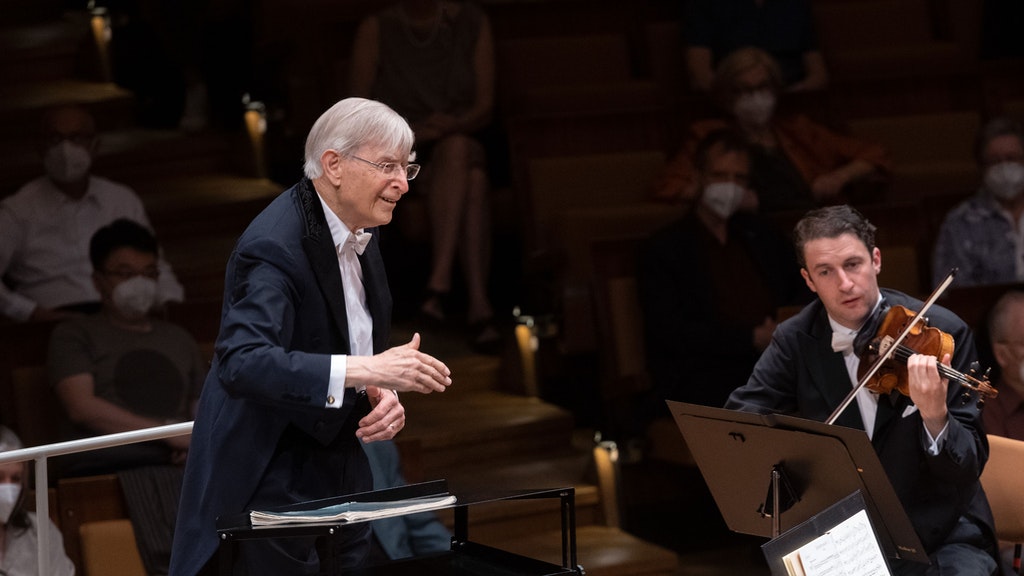 Germany Brahms, Sibelius: Berlin Philharmonic Orchestra / Herbert Blomstedt (conductor). Livestreamed on the Berliner Philharmoniker Digital Concert Hall (click here) from the Berlin Philharmonie, 12.6.2021. (GT)
Germany Brahms, Sibelius: Berlin Philharmonic Orchestra / Herbert Blomstedt (conductor). Livestreamed on the Berliner Philharmoniker Digital Concert Hall (click here) from the Berlin Philharmonie, 12.6.2021. (GT)

Sibelius – Symphony No.4 in A minor, Op.63
Brahms – Symphony No.3 in F major, Op.70
This was the penultimate concert at the Berlin Philharmonie in a season disrupted terribly by the pandemic. Last September at first audiences were permitted albeit in small numbers, then in the lockdown they were restricted only to live streaming until recently when as many as half the hall’s capacity could be allowed to attend. In his pre-concert interview Blomstedt called the opening Fourth Symphony by Sibelius ‘broodingly introspective’ and ‘his most personal’ work mentioning that it was written at a time in which the composer was battling cancer and abstaining from alcohol and cigars during a grim spell of ‘sheer agony’. It was also a ‘very private’ symphony. Blomstedt said that one of the unique aspects of the symphony is that ‘it’s based on a tritone, recurring from the very opening bars throughout all four movements’, and saying additionally that the music ‘asks many questions but gives few answers.’
The beginning of the first movement, Tempo molto moderato, quasi adagio was forebodingly dark in the basses and bassoons and a cello solo by Ludwig Quandt brought light in rising to a beautiful passage, supported by the strings. There was more reflection into darkness from the brass as the harmony transposed into a glorious passage heard on the strings and there was especially fine playing from Jonathan Kelly on the oboe and clarinet of Wenzel Fuchs before the close. The oboe was prominent in the second movement Allegro vivace with a bright idea on strings in an engaging dancing theme, yet the brass brought dissonance that was echoed by the woodwind leading to the charming idea introduced by the flute of Egor Egorkin. The third movement, Il tempo largo started with an enticing notion on both flutes and clarinet followed by anguished strings accentuated by the basses and trombones. Throughout Blomstedt (now in his 94th year) coaxed his players gently and eloquently waving his hands like a magician. In the finale, Allegro, elements of brightness returned with a solo from the cello of Quandt, picked up charmingly on the viola of Naoko Shimizu and there emerged a sense of momentous growth in an upbeat tempo. Then underpinning the tragic idiom of the symphony there came a descent into nothingness, and with bird-like calls from the woodwind the symphony ended on a desolate A minor chord.
There could hardly be a greater contrast between the Nordic gloomy darkness of Sibelius’s Fourth and the richly buoyant Central European romanticism of Brahms’s sunniest of symphonies. Blomstedt said that the composer’s Third Symphony ‘abounds with full emotion and drama’ and is ‘heroic in character’ invoking the words of Hans Richter – the first conductor of this symphony – who called it Brahms’s ‘Eroica’. However, there is interestingly the connotation of this work being also based on three notes F-A-F which is heard in the opening three measures – from the woodwinds and brass – of the Allegro con brio and introducing a stirringly glorious harmony. It was followed by some especially fine virtuosity from the clarinet of Fuchs and offered a complete change from the forbidding Sibelius symphony and confirmed we were undoubtedly in a quite different musical idiom. In the second movement (Andante) there was again exceptional playing from the clarinet and oboe enhanced by heavenly playing from the Berliners’ strings. In the Poco allegretto, this marvellous performance continued with a notably fine horn solo from Stefan Dohr creating a poetically transparent lyricism. The finale Allegro – Un poco sostenuto brought drama in the basses, dazzling colour on the woodwind, and some glorious playing sounding thrillingly dramatic especially from the strings of the orchestra. Blomstedt brought out all the romanticism of Brahms’s music and clearly this concert was well-prepared both in rehearsal and for bringing it to life in concert. This great work slowly closed peacefully as if unwinding the energy of the symphony’s splendid romanticism. It is a remarkably happy symphony by a composer who was at the peak of his creativity with that motto F-A-F – ‘Frei aber frohe’ (‘Free but happy’) – recurring throughout the masterpiece. One hopes that this great Swedish/American conductor will grace yet more concerts here in Berlin soon.
Gregor Tassie
